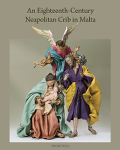 Autore: Edgar Vella
Autore: Edgar Vella
Titolo: An Eighteenth-Century Neapolitan Crib in Malta
In inglese. Text in english
Descrizione: Volume rilegato, in formato 8° (cm 28 x 24); 144 pagine; riccamente illustrato a colori; peso Kg 1,10
Luogo, Editore, data: Malta, Midsea Books, 2011
ISBN: 9789993273875
Disponibilità: NO disponibile
La storia di Napoli è costellata sia di sacerdoti incantati dal Mistero del Natale, che di santi come Gaetano da Thiene, Giuseppe Calasanzio e Alfonso Maria de' Liguori. Questo libro illustra il presepe napoletano di Padre Edgar Vella. Il Presepe Napoletano ebbe successo principalmente per tre fattori: luce, forma e colore che, fuse insieme, rivelano l'amore infinito di Dio verso l'umanità
al punto di prendere la forma di uomo e di essere nato povero tra i poveri, di redimere tutti allo stesso modo: i ricchi, i potenti, i diseredati, gli emarginati, gli afflitti, i sofferenti, gli oppressi. Questa forma di artigianato di altissimo valore artistico ha sempre attratto le più svariate personalità: principi, sovrani, banchieri, commercianti, prelati, umili sacerdoti, fedeli, non credenti, ma, soprattutto, ha creato una favolosa ed abbagliante e atmosfera, che lascia adulti e bambini incantati, e li fa vivere in paradiso per un po'.
Nei primi anni 1990 don Edgar acquistò le sue prime figure del presepe in mercatini di antiquariato di Londra: una Madonna di Lorenzo Mosca, un San Giuseppe di Nicola Somma, e una figura di rustico di Genzano, acquisti veramente fortunati. Nel tempo seguirono altri acquisti e, attraverso l'osservazione meticolosa, l'analisi e la ricerca, si aggiunsero altri importanti nomi della scultura presepiale del Settecento: Francesco Viva, Giuseppe De Luca, altri pezzi di Lorenzo Mosca, Giuseppe Gori, Francesco e Camillo Celebrano, Salvatore Franco, Nicola e Aniello Ingaldi, Francesco Cappiello. Molte figure presepiali della collezione Vella possono essere datate all'apertura delle varie botteghe sorte nel Settecento a Napoli, alcune delle quali di estrema importanza, come quella di Giuseppe Sanmartino, il caposcuola della scultura napoletana. La collezione di don Edgar è cresciuta in questi anni fino a quando non ha raggiunto un numero considerevole di figure. Ciò ha dato origine alla necessità di esporre la collezione al pubblico e di comunicare al popolo maltese la gioia di possedere tali opere d'arte.
The history of Naples is dotted with priests enchanted by the Mystery of Christmas, such as saints like Cajetan of Thiene, Joseph Calasanzio, and Alphonse Maria De' Liguori.This book is about Fr Edgar Vella Neapolitan crib which knows its success mainly to three factors: light, form, and colour, that, fused together, reveal the infinite love of God towards humanity to the point of taking the form of man and being born poor among the poor, to redeem all in the same manner: the rich, the powerful, the underprivileged, the marginated, the afflicted, the suffering, the downtrodden. This form of craftsmanship of the highest artistic value has always attracted the most varied personalities: from princes to sovereigns, from bankers to merchants, from prelates to humble priests, from devotees to unbelievers, but, above all, it has created a dazzling and fable-like atmosphere that leaves both adults and children enchanted, and makes them live in paradise for the moment.
In the early 1990s Fr Edgar acquired his first crib figures at antique markets in London, among which a Madonna by Lorenzo Mosca, a St Joseph by Nicola Somma, and a rustic figure by Genzano, truly lucky acquisitions. By time other acquisitions followed and, through meticulous observation, analysis, and research, other important names of crib sculptures from the Settecento came forth: Francesco Viva, Giuseppe De Luca, other pieces by Lorenzo Mosca, Giuseppe Gori, Francesco and Camillo Celebrano, Salvatore Franco, Nicola and Aniello Ingaldi, Francesco Cappiello. Many crib figures are to be dated to the setting of the various workshops that emerged in eighteenth-century Naples, some of which of extreme importance, such as that of Giuseppe Sanmartino, the caposcuola of Neapolitan sculpture. Fr Edgar's collection has grown throughout these years until it has reached a substantial number of figures. This fact gave rise to the need of exhibiting the collection to the general public and to communicate to the Maltese people the joy of owning such works of art.


